Now that they are so obviously 'styled', the danger is that these new Mercedes-Benzes will date more quickly and lose the air of permanence that was once one of the marque's defining characteristics.
So it's perhaps a surprise that the outgoing SL was in production for 10 years, and that it looked fresh to the end with just one little facelift along the way. Maybe it was one of the last pure Benzes; certainly it was a handsome, taut-looking sports car which disguised the need to stow its bulky coupé-cabriolet roof very well.
The new one is a predictable reinterpretation of the SL idea in the modern Mercedes image. It's slightly longer and slightly wider, the last things it needs to be in this congested world. Its body bears many of the SL sculpting tricks used since the first production SL (the 300SL 'Gullwing' coupé of 1955) – the scooped-out flanks with their pairs of strakes are the most obvious – but you can't help thinking that the rear three-quarter view could, roof excepted, equally belong to any recent Mercedes saloon.
However good the previous SL was (and it was), the sales figures alone showed the need for a new one. In the UK, the best-selling year was 2003 with 2686 cars sold. By contrast, just 279 found buyers last year, sales having continually sunk since their big crash in 2009. So the new SL needs to be something fresh and tempting in itself, not a mere remake.
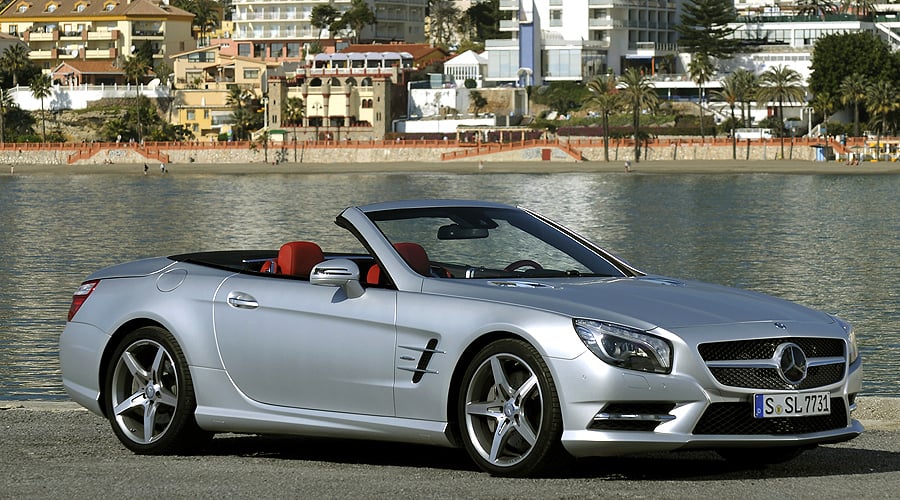
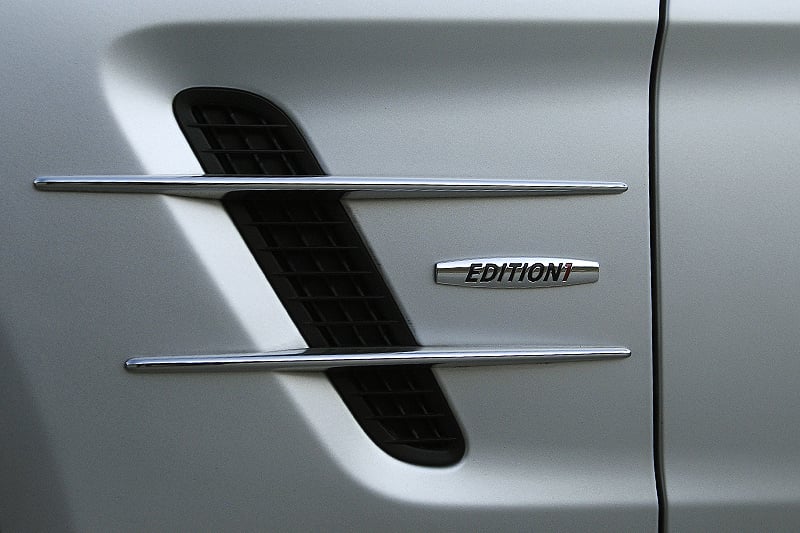
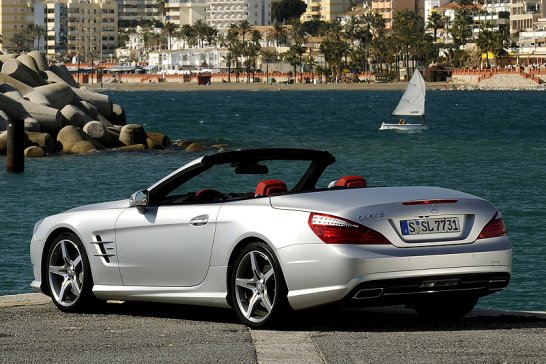
Inevitably, the quest for greater frugality with fuel dominates, plus the need to ensure the opulent SL has every driver aid and convenience feature that buyers feel they ought to have. After all, when you've paid for an easy life it would be a terrible thing to have to think.
Headline news here is that, like the Jaguar, the SL has a structure made entirely of aluminium apart from the steel reinforcements for the windscreen pillars. The lightweight metal is variously pressed, extruded, bonded, welded, riveted and – most intriguingly – cast. Doing that for suspension towers and the like is usual, but the SL also has cast bulkheads typically around 5mm thick. The result is that, engine-for-engine, the new SL has shed around 140kg compared with the old one.
Engine-for-engine? Actually it's not quite that simple. Keeping track of the Mercedes V8's evolution is a tricky business, but in this latest form the SL500's motor has a 4663cc capacity, direct injection and twin turbochargers to help it to 435bhp. By modern turbo-engine standards, then, this is not a highly stressed unit which perhaps helps explain its claimed 31.0mpg on the official Combined test cycle. Mercedes-Benz shouts that this is a 22 per cent economy increase, but that's as nothing compared with the latest version of the new range's other engine, the (non-turbo) SL350's V6. That one makes 306bhp from its 3499cc – yes, a Mercedes whose name really does reflect the engine capacity – and scored a scarcely-credible 41.5mpg, almost a 30 per cent improvement, in those fantasyland official tests.
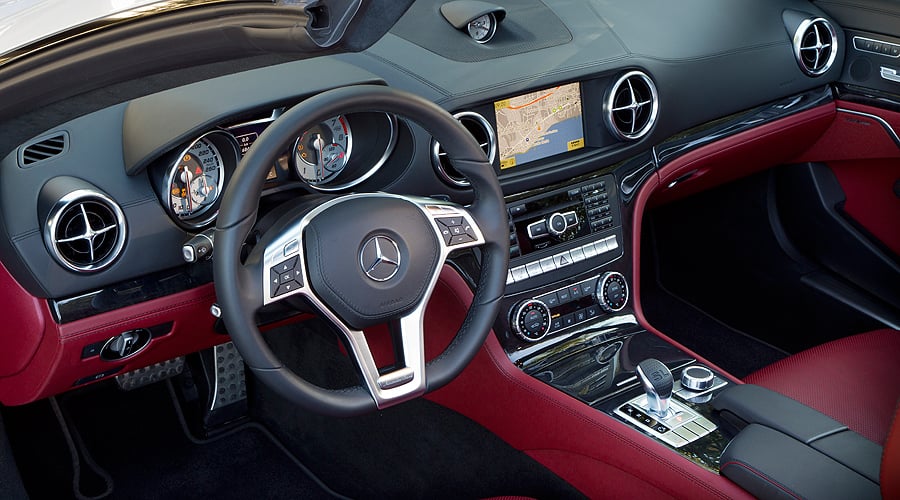
Stop-start systems and stratospheric seventh gears are the key to official-test success here, so please don't expect your new SL350 to be supermini-frugal. Of more real-world relevance is that the SL 500 now has 516lb ft of torque instead of 391, so not surprisingly it feels very swift. Pretty much as swift as the old supercharged SL55 AMG used to feel, in fact.
Other novelties? The roof can have a Magic Sky glass panel, able to tint itself electrochromically and ward off harmful or cabin-heating rays. There's further magic in the windscreen wipers, through the sides of which water is sprayed through rows of jets so the water lands just ahead of the blade, whichever the direction of wipe. (It's called Magic Vision Control.) The volumes between footwell and bulkhead, a neat, built-in resonance chamber, house FrontBass loudspeakers. And if you 'kick' a foot under the rear bumper, the boot will open automatically, provided the SL's key is on your person. That's not new, but being able to do the same thing to close the boot is.
Plenty of showroom appeal here, then. So why did the first SL500 I drove on the launch in southern Spain leave me cold? Partly it was because, on edging out into the town traffic, it felt cumbersome and the amply powered, electronically guarded interfaces of its controls made me feel curiously detached from the action, from the notion of ground passing under the wheels. That's not good in a sports car, if sports car the SL is.
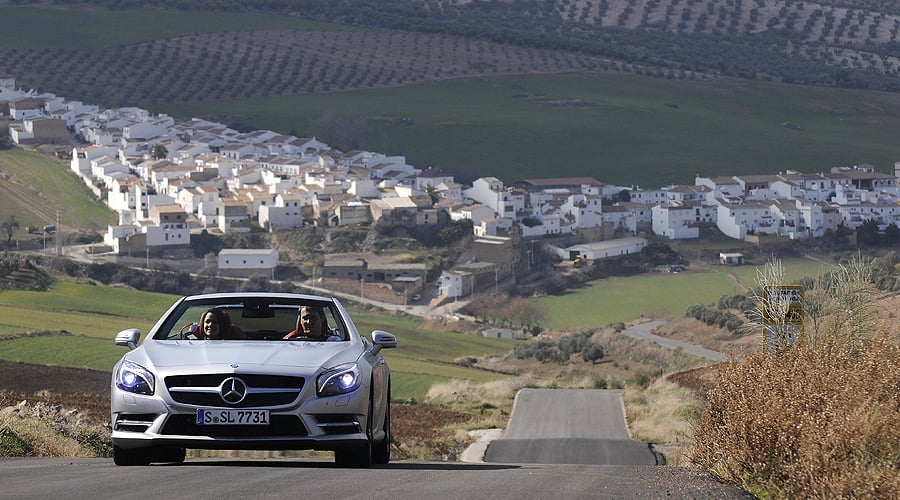
Then there was the ABC, or Active Body Control, optionally fitted to this car as it could be to the previous SL. This uses very stiff springs with hydraulic actuators within them, able to help the springs compress when the ride needs to be soft and reacting constantly to inputs of acceleration, braking, steering movements and cornering forces. There are no anti-roll bars, the hydraulics instead levelling the body so the only roll angle you detect is the result of the outside tyres' compression.
Remember, it's 'active'. Picture the scene. You're accelerating on an undulating road. The SL500 has a very aggressive throttle response, especially in the automatic's Sport mode, while the ABC system can be caught out by undulations and make the ride turn suddenly choppy, even in its own Comfort mode. Result: an upward jerk causes your right foot to nudge the accelerator and off you squirt, in a continuing, positive-feedback-loop series of lunges.
Then you get to some tight bends, and the Direct-Steer system makes the SL unnaturally 'darty' once you're past the more calmly geared steering response around the straight-ahead. Fluent driving is barely any easier here than it was in the famously hyperactive, yet surreally anaesthetised, SLR McLaren.
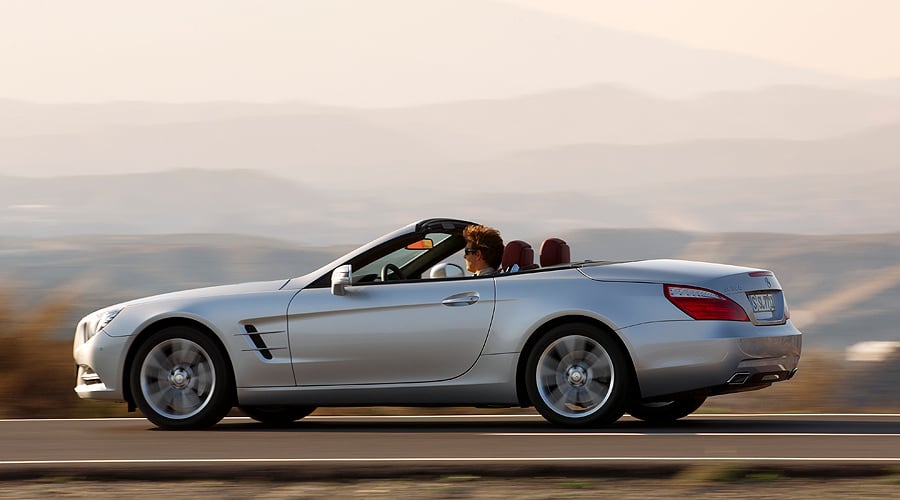
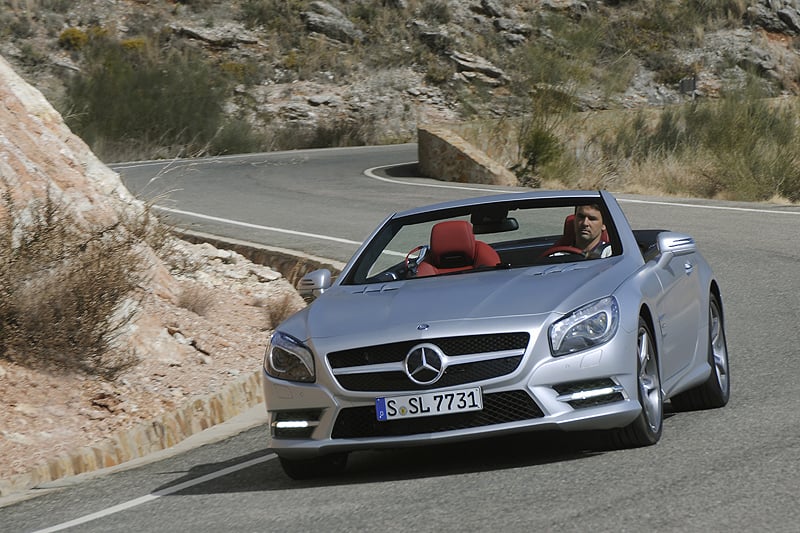
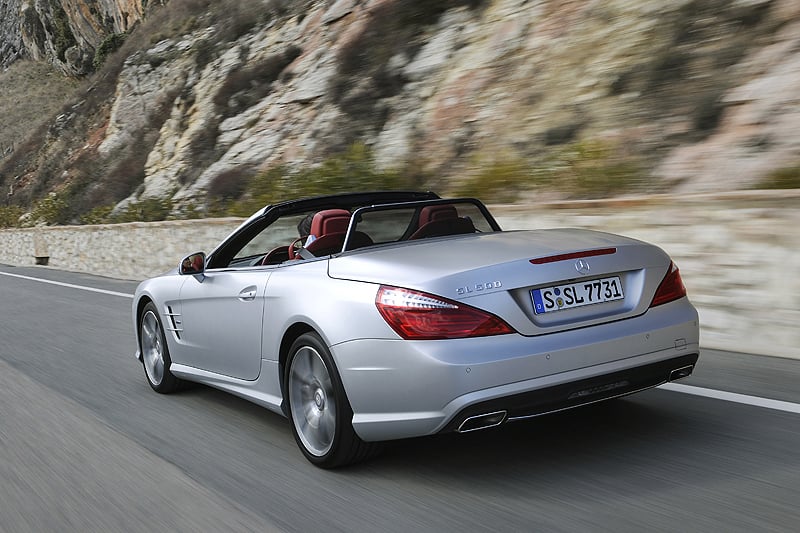
On the plus side, there is never the slightest tremor from the open-top structure, wind noise with the roof up is practically zero, and roof-down the wind rush is never so vigorous as to become wearing, especially with the electric windblocker deployed. The drag coefficient is just 0.32 with the roof down, a result even more impressive than the 0.27 roof-up figure.
Day two dawns, and I try a different SL500 (there are no SL350s to drive). This one has the other suspension configuration: standard springs (a firmer 'sport' version with AMG cosmetics is also offered) with adaptive dampers and normal anti-roll bars. And now I can feel the SL more as it is meant to be, hidden behind fewer layers of technological firewall. Yes, the steering is still unnaturally reactive off-centre, but the effect is damped by the natural build-up of body roll, and the SL feels wedded to the road instead of skimming just above it.
The Sport suspension setting is too firm and the Sport transmission setting again too frantic, but if you stay in the gentle modes and live on the engine's fabulous torque, you can have a fine time. Or use the manual paddleshifts, revelling in the V8's blattery beat and the gearbox's quick, neat shifts. Now you can really enjoy pace that will see 62mph reached 4.6 seconds from standstill, with sound effects to match.
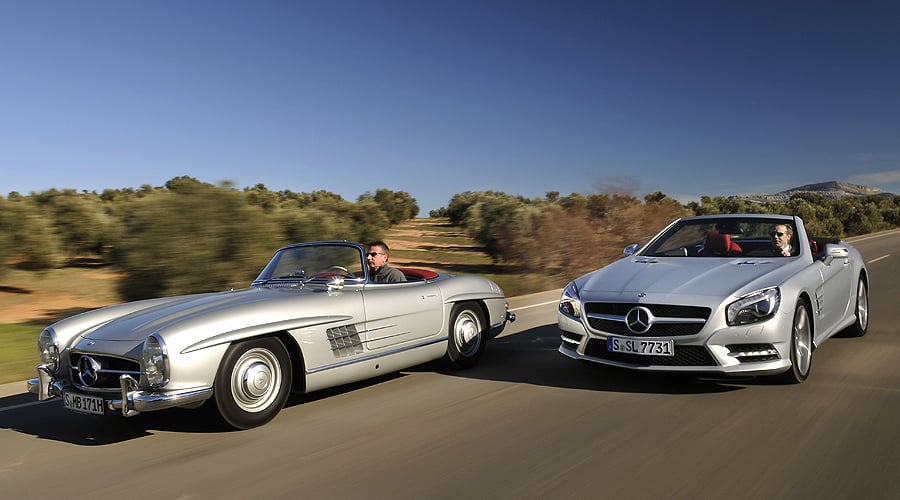
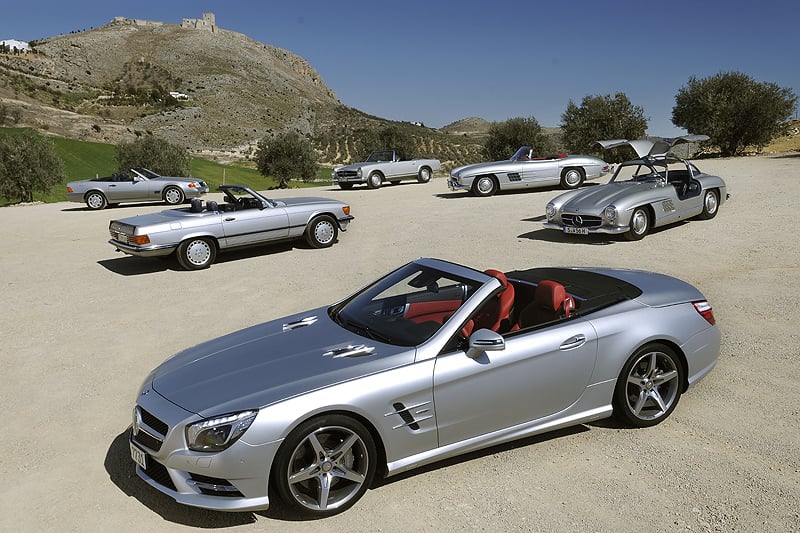
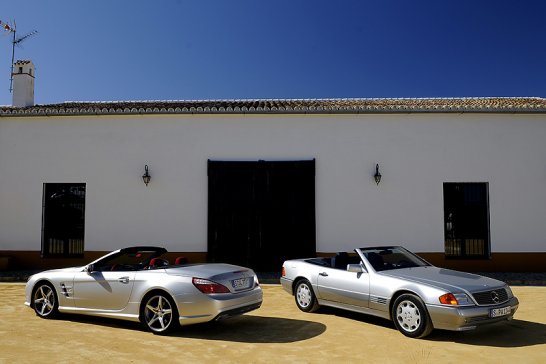
In the end, then, I liked the new SL, although I wonder slightly at the point of it. It's not really a sports car, although it certainly goes like one. It's a very rapid, two-seater luxury tourer which will doubtless find eager buyers at around £80,000 for the SL500 and a little over £70,000 for the SL350. Trouble is, Mercedes-Benz also laid on some earlier SLs to try (not including the outgoing model), one of which was a 1960-ish 300SL Roadster in silver.
It was magnificent: quick, torquey, sonorous, easy to drive with its neat manual gearchange, not too heavy in the steering. Compact, wieldy and in touch with the terrain, too. I felt I could cross a continent in it, and lap up every kilometre. Simple, it seems, is ultimately best for true enjoyment, and it makes you wonder exactly where we have been heading these past 50 years.
Somewhere in the new SL is a great car, smothered by layers of technodazzle. Keep it simpler, chaps.
Photos: Daimler













